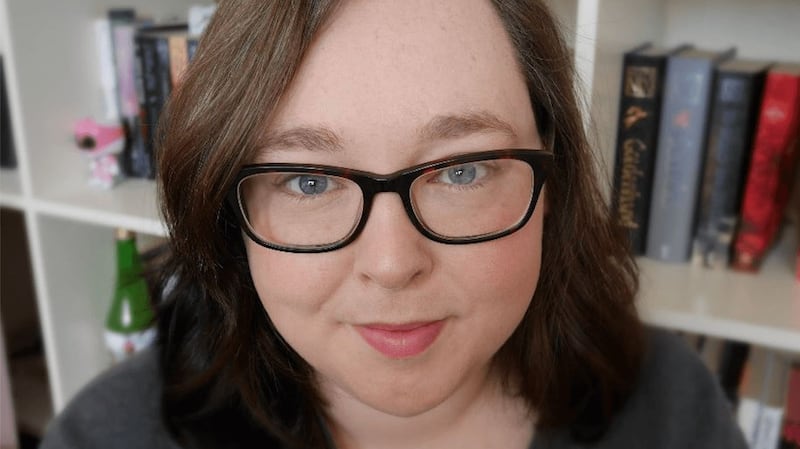“I grew up watching Buffy,” Amy Clarkin begins when I ask her about the influences on her ghost novel, What Walks These Halls, published by O’Brien Press earlier this year. It’s a detail that makes perfect sense given the “found family” feel in Clarkin’s book, which focuses on a misfit group of teenage and early-twenty-something ghosthunters who will return for a sequel next spring. But it also makes sense for a certain generation of writers – not just Irish, of course, but a generation that within Ireland had not just the opportunity to be dazzled by American pop culture (that was nothing new) but to feel closer to it, part of it, as online activity exploded at the end of the century.
Buffy the Vampire Slayer (1997-2003), a TV series subverting traditional horror expectations (the tiny blonde girl who would typically be the victim turns out to be the kick-ass heroine, complete with quippy one-liners as she defeats the bad guys), has been subject to much analysis, both academic and fan-led (there is a definite overlap between the two). Today the idea of an internet subculture, complete with specific vocabulary and what may look like a great deal of overthinking to an outsider, is something even a devoted Luddite might be expected to have a passing familiarity with. This mode of being didn’t necessarily originate with turn-of-the-millennium online fandom, but it was certainly crystallised there.
For writers and consumers of fiction, whether on the page or screen, what this means is a heightened awareness. The global nature of online discourse trends heavily towards the United States, evident not just in the serious political issues but in the cultural. St Patrick’s Day parades began here in the early 20th century, centuries after they’d been happening in the US; Halloween may have its origins as a Celtic festival but it’s an Americanised – and capitalism-friendly – version we celebrate today. If we think of particularly Irish ghost or horror stories, we lean towards the traditional, rather than contemporary (though there is a nod towards this tradition as ongoing, rather than dead, in broadcaster Anne Doyle’s new anthology of ghost stories, Tales of the Otherworld).
Sometimes it’s easier to face the things that scare or challenge us when they’re a monster to be defeated
— Amy Clarkin, author
Dark, supernatural forces are alive and well in contemporary Irish fiction, however, and this is particularly evident in young adult fiction – in part because the supernatural has long provided a useful metaphor for the horrors of adolescence. As Clarkin puts it, “horror, and especially the supernatural, gives us a space to explore the things that scare us in a safe way – we know we can put the book down or pause the film whenever we need to. Sometimes it’s easier to face the things that scare or challenge us when they’re a monster to be defeated.” There are real ghosts in her book, but as she notes, “there are many ways to be haunted, and everyone in this book is haunted by more than the ghost they’re facing.”
Deirdre Sullivan’s latest novel, Wise Creatures (Hot Key Books), similarly focuses on hauntings that are both real and metaphorical, with narrator Daisy shaped by a childhood in which her mother exploited her psychic abilities. “I wanted it to feel grounded in emotional truth,” she says, “and using the ghosts allowed me to embody the unspoken trauma. It allowed me to warp and amplify the real world in ways that I hope convey to the reader the very real impact of negotiating the world in the wake of various forms of abuse.”
In both these novels, firmly set in contemporary Ireland, we see nods to specifically Irish folklore and history – Clarkin’s chilling The Lady is inspired by traditional sources while Sullivan cites Elizabeth Bowen, Dorothy Macardle, Rosa Mullholland and Clotilde Graves among her many influences.

The literary heritage is not always as influential as it might seem, though. Meg Grehan’s Baby Teeth (Little Island) is a sapphic vampire novel-in-verse with echoes of Le Fanu’s Carmilla and has its origins in a far more pragmatic concern. Grehan’s use of vampires – a variation that sees them carry around all of their past selves inside them – came about “largely to avoid uncomfortable age-differences between my characters. I knew I wanted a romance in the book but I personally don’t love when ancient vampires are in relationships with younger characters”.
The much-overused and yet often apt term “problematic” can be applied to many vampire romances, sparkly or otherwise; the attention to this does reflect the younger generation of writers, with an eye on avoiding particular troublesome tropes.
[ YA fiction: Fragmented time, censorship and an utter wagon of a teacherOpens in new window ]
Fantasy writer Helen Corcoran, whose second novel, Daughter of Winter and Twilight (O’Brien Press) landed on shelves last month, has similarly assessed her genre with a critical, thoughtful brain. “Growing up as a fantasy reader,” she says, “it was impossible to escape that girls and women were often an accessory to a male character’s journey, and that a lot of fantasy worlds were patriarchal. All of this detailed world-building and magic, and yet no one seemed to consider that the patriarchy didn’t have to exist.”
Her own books involve “predominantly female casts” and avoid heterosexuality as the default; as Corcoran puts it, “my characters have 99 plot problems, but homophobia isn’t one of them”.
It is tempting to attribute the more inclusive, progressive and diverse atmosphere of these titles to a more globalised world, and to international influence, but it is also reductive, and undermines the extent to which Ireland has changed in recent decades. YA writers in particular are all too aware of the backlash towards feminist and LGBTQ+ rights led by the United States, which has influenced protests and book challenges in some Irish libraries.
Despite this – and perhaps linked to a sense that YA should offer hopeful, if not necessarily happy endings (as Sullivan puts it, “there has to be something that sustains the character’s hunger to remain in the world, a sense of possibility, however small”) – there is tremendous optimism from these writers of dark tales.
Fantasy is broadening as a genre, and I think publishing is finally starting to see that it appeals to more than straight, white male readers
— Helen Corcoran, author
“Despite the challenges,” Grehan says, “it has been the most joyful and fulfilling experience of my life being a queer author of queer books.” She adds, “queerness can be so many things for so many people and putting these restrictions on it also restricts personal growth and personal knowledge, it holds people back from really knowing themselves and each other.” She has a great deal of praise for her publisher, Little Island, who allow her a “liberating and empowering” freedom. “It makes me feel comfortable exploring tougher topics or even ones that might make some people a little unhappy because I know the people I’m working with and know they have my back and believe in my work and the messages I want to send.”
[ How a celebrated Dublin bookstore has started a new chapter thanks to BookTokOpens in new window ]
Clarkin is similarly enthused over YA as a field, appreciating that it “gives such scope for exploring coming of age narratives in really varied and exciting ways”. It’s a sentiment that comes up for Sullivan also: “If I were an adult writer, my books would be shelved in different sections of the bookshop. In Young Adult, you can produce a body of work that’s varied but still sits comfortably together, and I really appreciate that, as a writer. What a gift to get to do your own weird thing.”
And even having noted the patriarchal defaults of fantasy, Corcoran agrees with this sense of a hopeful future. “Fantasy is broadening as a genre, and I think publishing is finally starting to see that it appeals to more than straight, white male readers. It still has a long way to go, but there’s such new ground being broken in the genre, and the work of marginalised writers – both new and those who came before us – is starting to be recognised.”
Worth reading...
Other dark supernatural Irish YA to curl up with this Halloween: Sarah Maria Griffin’s Spare and Found Parts; Moira Fowley’s All The Bad Apples and, for older teens, her adult collection Eyes Guts Throat Bones; Caroline O’Donoghue’s Gifts trilogy, beginning with All Our Hidden Gifts; Peadar O’Guilin’s The Call and The Invasion; Aislinn O’Loughlin’s Big Bad Me. For eerie short stories (for both teens and adults), Sullivan recommends seeking out anthologies, with their “sense of many voices around a fireside chilling and comforting each other”, citing Ireland’s Swan River Press in particular, as well as recent collections by Mariana Enríquez, Cassandra Khan, Bora Chung, Carmen Maria Machado and Agustina Bazterrica.





















